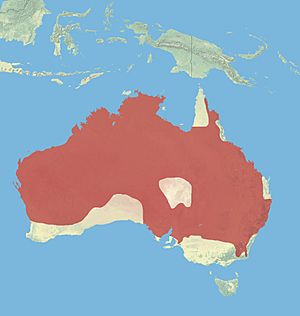Common wallaroo facts for kids
Quick facts for kids Wallaroo |
|
|---|---|
 |
|
| Euro (Osphranter robustus erubescens) | |
| Conservation status | |
| Scientific classification | |
| Genus: |
Osphranter
|
| Species: |
robustus
|
| Subspecies | |
|
|
 |
|
| Common wallaroo range | |
The common wallaroo (Osphranter robustus) is a type of macropod. This means it belongs to the same family as kangaroos and other wallabies. People also call it the euro, hill wallaroo, or just wallaroo. The name "euro" is often used for one specific kind of wallaroo called O. r. erubescens.
Wallaroos are mostly active at night, which means they are nocturnal. They usually like to be alone. Wallaroos are quite common in Australia. If you get too close, they might make a loud hissing sound! Like many wallaroos, the males and females can look different. This is called sexual dimorphism.
Contents
What are the Different Types of Wallaroos?
There are four main types, or subspecies, of the common wallaroo. Each one lives in a different part of Australia and has slightly different features:
Eastern Wallaroo (O. r. robustus)
This wallaroo lives in eastern Australia. The males have dark grey fur. They look a bit like the black wallaroo. Female eastern wallaroos are lighter in color, often a sandy brown.
Euro or Western Wallaroo (O. r. erubescens)
You can find this type across most of the wallaroo's western range. Their fur color can vary, but it's usually brownish.
Barrow Island Wallaroo (O. r. isabellinus)
This wallaroo lives only on Barrow Island in Western Australia. It's smaller than the other types. Its fur is a uniform reddish-brown color.
Kimberley Wallaroo (O. r. woodwardi)
This subspecies lives in the Kimberley region of Western Australia and also in the Northern Territory. It's the lightest in color of all the wallaroos, with dull brown-grey fur. Local Indigenous people, the Kunwinjku, have special names for this wallaroo. They call it ngabudj. They also have different names for males (galkibard) and females (wallaar). A very large male is called ganduki. This wallaroo is tough! It can live well in places without much water and eat grasses that don't have many nutrients. However, it does need places to find shelter.
How Do Wallaroos Have Babies?
Wallaroos don't have a specific mating season. Female wallaroos can actually give birth at any time of the year! They have a special ability called embryonic diapause. This means they can get pregnant again soon after giving birth. But the new baby (embryo) won't start growing until the older baby (joey) is ready to leave the mother's pouch. Male wallaroos can have many female partners. This is called being polygynous.
Mating and Fighting
When it's time to mate, male wallaroos will often fight to get the attention of a female. These fights usually don't end with one wallaroo dying. Instead, they will keep fighting until one of them gives up.
Baby Wallaroos (Joeys)
A wallaroo pregnancy lasts about 30 to 38 days. After this, the tiny new joey crawls into its mother's pouch. There, it drinks milk and continues to grow and develop. Young joeys start to peek out of the pouch around six months old. By nine months, they usually don't spend most of their time in the pouch anymore. Male wallaroos become fully grown when they are about 18 to 20 months old. Females are fully grown a bit earlier, at around 14 to 24 months.
Family Life
The relationship between a joey and its parents changes as it grows. While the joey is still in the pouch, the father often stays nearby. He helps protect the mother and baby from dangerous animals. Once the joey is older and doesn't need this protection, the father's role becomes less important. However, even after the joey no longer needs its mother for food, it often stays close to her.
Are Wallaroos Endangered?
Overall, the common wallaroo species is not considered to be in danger. However, one specific type, the Barrow Island wallaroo (O. r. isabellinus), is classified as vulnerable. This means it could become endangered if its situation doesn't improve.
Wallaroo Classification
Scientists sometimes change how they classify animals as they learn more. In 2019, experts looked closely at macropods again. They decided that the common wallaroo should be moved from the genus Macropus to the genus Osphranter. The Australian Faunal Directory officially accepted this change in 2020.
Images for kids
See also





